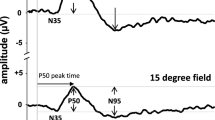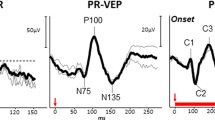Abstract
Purpose of the Review
The clinical management of glaucoma is currently focused on manifest stages of the diseases at which there are congruent losses of visual function and optic nerve tissue. Identification of patients at risk of developing glaucoma remains a challenge. Detection of retinal ganglion cell dysfunction in glaucoma suspects may represent a way of identifying patients at high-risk glaucoma and thus provide both a rationale and a target for treatment to change the natural history of the disease. This report provides a review of the current applications of the pattern electroretinogram (PERG) to investigate electrical responsiveness of retinal ganglion cells in early glaucoma.
Recent Findings
While the PERG technique has been in use since the 1980’s, only recently PERG methods have been developed with skin electrodes and automated analysis that expand the PERG application in the clinical setting.
Summary
The PERG may be altered at stages of glaucoma that precede losses of visual field and optic nerve tissue. PERG alterations may be progressive and reversible after IOP lowering. PERG alterations may be inducible in susceptible eyes of patients at risk of glaucoma.





Similar content being viewed by others
References
Papers of particular interest, published recently, have been highlighted as: •• Of major importance
Maffei L, Fiorentini A. Electroretinographic responses to alternating gratings before and after section of the optic nerve. Science. 1981;211(4485):953–5.
Fiorentini A, et al. The ERG in response to alternating gratings in patients with diseases of the peripheral visual pathway. Invest Ophthalmol Vis Sci. 1981;21(3):490–3.
Zrenner E. The physiological basis of the pattern electroretinogram. In: Osborne N, Chader G, editors. Progress in retinal research. Oxford: Pergamon Press; 1990. p. 427–64.
Porciatti V., Electrophysiological assessment of retinal ganglion cell function. Exp Eye Res, 2015.
Holder GE. Pattern electroretinography (PERG) and an integrated approach to visual pathway diagnosis. Prog Retin Eye Res. 2001;20(4):531–61.
Porciatti V, et al. Pattern electroretinogram as a function of spatial frequency in ocular hypertension and early glaucoma. Doc Ophthalmol. 1987;65(3):349–55.
Weinstein GW, et al. The pattern electroretinogram (PERG) in ocular hypertension and glaucoma. Arch Ophthalmol. 1988;106(7):923–8.
Berninger TA, Arden GB. The pattern electroretinogram. Eye. 1988;2(Suppl):S257–83.
Bach M. Electrophysiological approaches for early detection of glaucoma. Eur J Ophthalmol. 2001;11(Suppl 2):S41–9.
•• Bode SF , Jehle T, Bach M. Invest Ophthalmol Vis Sci. 2011 Jun 16;52(7):4300–6. Pattern electroretinogram in glaucoma suspects: new findings from a longitudinal study. This longitudinal study in glaucoma suspects detected PERG changes 4 years before visual field changes
Pfeiffer N, Tillmon B, Bach M. Predictive value of the pattern electroretinogram in high-risk ocular hypertension. Invest Ophthalmol Vis Sci. 1993;34(5):1710–5.
•• Banitt MR, et al. Progressive loss of retinal ganglion cell function precedes structural loss by several years in glaucoma suspects. Invest Ophthalmol Vis Sci. 2013;54(3):2346–52. This longitudinal study in glaucoma suspects determined that the time lag between 10% loss of PERG signal and equivalent loss of RNFL thickness was 8 years. This represents a substantial window for intervention before permanent loss of structure from glaucoma
Nesher R, et al. Steady-state pattern electroretinogram following long term unilateral administration of timolol to ocular hypertensive subjects. Doc Ophthalmol. 1990;75(2):101–9.
Colotto A, et al. Pattern electroretinogram in treated ocular hypertension: a cross-sectional study after timolol maleate therapy. Ophthalmic Res. 1995;27(3):168–77.
Falsini B, et al. Follow-up study with pattern ERG in ocular hypertension and glaucoma patients under timolol maleate treatment. Clinical Vision Sciences. 1992;7(4):341–7.
Papst N, Bopp M, Schnaudigel OE. The pattern evoked electroretinogram associated with elevated intraocular pressure. Graefes Arch Clin Exp Ophthalmol. 1984;222(1):34–7.
Ventura LM, Porciatti V. Restoration of retinal ganglion cell function in early glaucoma after intraocular pressure reduction: a pilot study. Ophthalmology. 2005;112(1):20–7.
Sehi M, et al. Reversal of retinal ganglion cell dysfunction after surgical reduction of intraocular pressure. Ophthalmology. 2010;117(12):2329–36.
Colotto A, et al. Transiently raised intraocular pressure reveals pattern electroretinogram losses in ocular hypertension. Invest Ophthalmol Vis Sci. 1996;37(13):2663–70.
Ventura LM, et al. Head-down posture induces PERG alterations in glaucoma suspects. Invest Ophthalmol Vis Sci. 2008;49(5):2876.
Giuffre I, et al. Pattern electroretinogram assessment during ibopamine test in ocular hypertension. Eur J Ophthalmol. 2013;23(6):819–22.
•• Porciatti V, Ventura LM. Retinal ganglion cell functional plasticity and optic neuropathy: a comprehensive model. J Neuroophthalmol. 2012;32(4):354–8. This study provides a theoretical framework for structure-function relationship in glaucoma and optic nerve degenerations
Porciatti V, Ventura LM. Normative data for a user-friendly paradigm for pattern electroretinogram recording. Ophthalmology. 2004;111(1):161–8.
•• Bach M, Ramharter-Sereinig A. Pattern electroretinogram to detect glaucoma: comparing the PERGLA and the PERG ratio protocols. Doc Ophthalmol. 2013;127(3):227–38. This study compares the PERGLA method to other methods for PERG recording in glaucoma
Bowd C, et al. Repeatability of pattern electroretinogram measurements using a new paradigm optimized for glaucoma detection. J Glaucoma. 2009;18(6):437–42.
Bowd C, et al. Diagnostic accuracy of pattern electroretinogram optimized for glaucoma detection. Ophthalmology. 2009;116(3):437–43.
Fredette MJ, et al. Reproducibility of pattern electroretinogram in glaucoma patients with a range of severity of disease with the new glaucoma paradigm. Ophthalmology. 2008;115(6):957–63.
Yang A, Swanson WH. A new pattern electroretinogram paradigm evaluated in terms of user friendliness and agreement with perimetry. Ophthalmology. 2007;114(4):671–9.
Bowd C, et al. Pattern electroretinogram association with spectral domain-OCT structural measurements in glaucoma. Eye (Lond). 2011;25(2):224–32.
Forte R, et al. Pattern electroretinogram optimized for glaucoma screening (PERGLA) and retinal nerve fiber thickness in suspected glaucoma and ocular hypertension. Doc Ophthalmol. 2010;120(2):187–92.
Ventura LM, et al. Pattern electroretinogram abnormality and glaucoma. Ophthalmology. 2005;112(1):10–9.
Ventura LM, et al. The relationship between retinal ganglion cell function and retinal nerve fiber thickness in early glaucoma. Invest Ophthalmol Vis Sci. 2006;47(9):3904–11.
Ventura LM, Porciatti V. Pattern electroretinogram in glaucoma. Curr Opin Ophthalmol. 2006;17(2):196–202.
Bach M, Hoffmann MB. Update on the pattern electroretinogram in glaucoma. Optom Vis Sci. 2008;85(6):386–95.
Bach M, Poloschek C. Electrophysiology and glaucoma: current status and future challenges. Cell Tissue Res. 2013;353(2):287–96.
Porciatti V. Electrophysiological testing in glaucoma. Expert Rev Ophthalmol. 2007;2(5):747–54.
Bach M, et al. ISCEV standard for clinical pattern electroretinography (PERG): 2012 update. Doc Ophthalmol. 2013;126(1):1–7.
Trick GL. Retinal potentials in patients with primary open-angle glaucoma: physiological evidence for temporal frequency tuning deficits. Invest Ophthalmol Vis Sci. 1985;26(12):1750–8.
Bach M, Speidel-Fiaux A. Pattern electroretinogram in glaucoma and ocular hypertension. Doc Ophthalmol. 1989;73(2):173–81.
Ventura LM, Feuer WJ, Porciatti V. Progressive loss of retinal ganglion cell function is hindered with IOP-lowering treatment in early glaucoma. Invest Ophthalmol Vis Sci. 2012;53(2):659–63.
Ventura LM, et al. Pattern electroretinogram progression in glaucoma suspects. J Glaucoma. 2013;22(3):219–25.
Spaeth GL, Vacharat N. Provocative tests and chronic simple glaucoma. I. Effect of atropine on the water-drinking test: intimations of central regulatory control. II. Fluorescein angiography provocative test: a new approach to separation of the normal from the pathological. Br J Ophthalmol. 1972;56(3):205–16.
Hatanaka, M., et al., Comparison of the intraocular pressure variation provoked by postural change and by the water drinking test in primary open-angle glaucoma and normal patients. J Glaucoma, 2016.
Ventura LM, et al. Head-down posture induces PERG alterations in early glaucoma. J Glaucoma. 2013;22(3):255–64.
Porciatti V, Ventura LM. Physiologic significance of steady-state pattern electroretinogram losses in glaucoma: clues from simulation of abnormalities in normal subjects. J Glaucoma. 2009;18(7):535–42.
Bach M, Mathieu M. Different effect of dioptric defocus vs. light scatter on the pattern electroretinogram (PERG). Doc Ophthalmol. 2004;108(1):99–106.
Ventura LM, et al. The PERG in diabetic glaucoma suspects with no evidence of retinopathy. J Glaucoma. 2010;19(4):243–7.
Holder GE. The pattern electroretinogram in anterior visual pathway dysfunction and its relationship to the pattern visual evoked potential: a personal clinical review of 743 eyes. Eye. 1997;11(Pt 6):924–34.
Sartucci F, et al. Changes in pattern electroretinograms to equiluminant red-green and blue-yellow gratings in patients with early Parkinson’s disease. J Clin Neurophysiol. 2003;20(5):375–81.
Peppe A, et al. Low contrast stimuli enhance PERG sensitivity to the visual dysfunction in Parkinson’s disease. Electroencephalogr Clin Neurophysiol. 1992;82(6):453–7.
Parisi V. Correlation between morphological and functional retinal impairment in patients affected by ocular hypertension, glaucoma, demyelinating optic neuritis and Alzheimer’s disease. Semin Ophthalmol. 2003;18(2):50–7.
Porciatti V, Sartucci F. Retinal and cortical evoked responses to chromatic contrast stimuli. Specific losses in both eyes of patients with multiple sclerosis and unilateral optic neuritis. Brain. 1996;119(Pt 3):723–40.
Lubinski W. Electroretinogram of the “pattern” type of eyes with medium grade myopia. Klin Ocz. 1991;93(10–11):284–5.
Birch DG, et al. Pattern-reversal electroretinographic follow-up of laser photocoagulation for subfoveal neovascular lesions in age-related macular degeneration. Am J Ophthalmol. 1993;116(2):148–55.
Porciatti V, Sorokac N, Buchser W. Habituation of retinal ganglion cell activity in response to steady state pattern visual stimuli in normal subjects. Invest Ophthalmol Vis Sci. 2005;46(4):1296–302.
Porciatti, V., et al., Adaptation of the steady-state PERG in early glaucoma. J Glaucoma, 2013.
Porciatti V, Ventura LM. Adaptive changes of inner retina function in response to sustained pattern stimulation. Vis Res. 2009;49(5):505–13.
Author information
Authors and Affiliations
Corresponding author
Ethics declarations
Conflict of Interest
Vittorio Porciatti and Lori M. Ventura declare no conflict of interest.
Human and Animal Rights and Informed Consent
This article does not contain any studies with human or animal subjects performed by any of the authors.
Financial Support
NIH-NEI RO1 EY014957 (VP), NIH-NEI center grant P30 EY014801 (VP), and by an unrestricted grant to Bascom Palmer Eye Institute from Research to Prevent Blindness.
Additional information
This article is part of the Topical Collection on Diagnosis and Monitoring of Glaucoma
Rights and permissions
About this article
Cite this article
Porciatti, V., Ventura, L.M. The PERG as a Tool for Early Detection and Monitoring of Glaucoma. Curr Ophthalmol Rep 5, 7–13 (2017). https://doi.org/10.1007/s40135-017-0128-1
Published:
Issue Date:
DOI: https://doi.org/10.1007/s40135-017-0128-1




